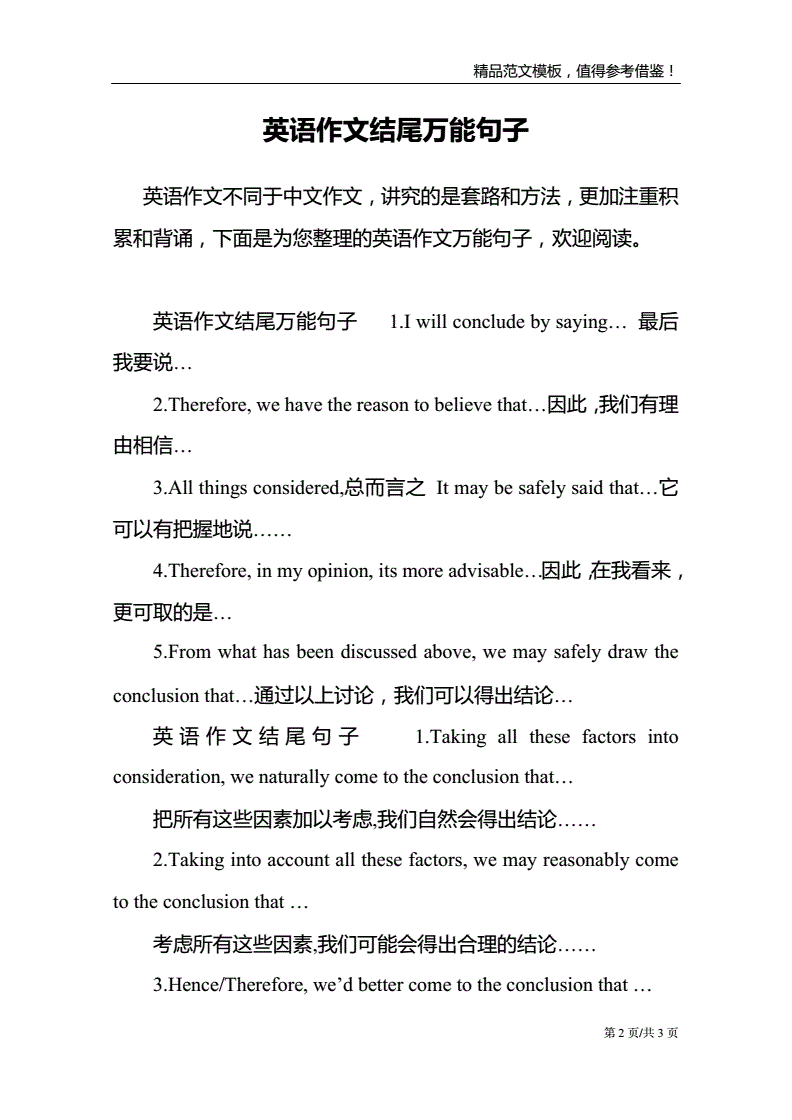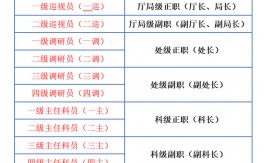英語(yǔ)作文萬(wàn)能結(jié)尾
英語(yǔ)作文的結(jié)尾部分應(yīng)該簡(jiǎn)潔有力,能夠總結(jié)全文并留給讀者深刻的印象。以下是一些萬(wàn)能的英語(yǔ)作文結(jié)尾句式,你可以[主題] 仍然是一個(gè)需要我們關(guān)注和行動(dòng)的重要問(wèn)題。
2. To sum up, [主題] is a multifaceted challenge that demands a comprehensive approach.
- 總之,[主題] 是一個(gè)多方面的問(wèn)題,需要全面的方法來(lái)應(yīng)對(duì)。
3. In wrapping up, it is clear that [主題] has far-reaching implications for [相關(guān)領(lǐng)域或群體].
- 在總結(jié)時(shí),很明顯 [主題] 對(duì) [相關(guān)領(lǐng)域或群體] 有著深遠(yuǎn)的影響。
4. Ultimately, the key to addressing [主題] lies in [解決方案或關(guān)鍵因素].
- 解決 [主題] 的關(guān)鍵在于 [解決方案或關(guān)鍵因素]。
5. As we bring this discussion to a close, it is evident that [主題] is a complex matter that warrants further exploration.
- 當(dāng)我們結(jié)束這次討論時(shí),很明顯 [主題] 是一個(gè)值得進(jìn)一步探索的復(fù)雜問(wèn)題。
6. In the final analysis, [主題] is not just a [描述], but also a [描述] that affects [影響的方面].
- 在最終分析中,[主題] 不僅僅是一個(gè) [描述],而且還是一個(gè)影響 [影響的方面] 的 [描述]。
7. To conclude, the importance of [主題] cannot be overstated, and it is imperative that we [采取的行動(dòng)或建議].
- 總之,[主題] 的重要性怎么強(qiáng)調(diào)都不為過(guò),我們必須 [采取的行動(dòng)或建議]。
8. As we reflect on the topic of [主題], it is imperative to recognize the role of [相關(guān)因素] in shaping the future of [相關(guān)領(lǐng)域].
- 當(dāng)我們反思 [主題] 時(shí),認(rèn)識(shí)到 [相關(guān)因素] 在塑造 [相關(guān)領(lǐng)域] 未來(lái)中的作用是至關(guān)重要的。
9. In closing, let us not forget that [主題] is a shared responsibility that requires the collective efforts of [相關(guān)群體].
- 在結(jié)束時(shí),讓我們不要忘記 [主題] 是一個(gè)共同的責(zé)任,需要 [相關(guān)群體] 的集體努力。
10. To encapsulate the essence of [主題], it is a [描述] that we must [建議或行動(dòng)] to ensure [期望的結(jié)果].
- 為了概括 [主題] 的本質(zhì),它是一個(gè)我們必須 [建議或行動(dòng)] 以確保 [期望的結(jié)果] 的 [描述]。
記得在實(shí)際寫作中,使其更加貼合你的作文。

英語(yǔ)萬(wàn)能模板作文
英語(yǔ)作文并沒(méi)有所謂的“萬(wàn)能模板”,因?yàn)椴煌淖魑念}目和要求需要不同的寫作策略和內(nèi)容。但是,可以提供一些常見的作文結(jié)構(gòu)和句型,這些可以幫助你構(gòu)建一篇結(jié)構(gòu)清晰、邏輯嚴(yán)密的英語(yǔ)作文。以下是一些基本的寫作框架和句型:
引言(Introduction)
- "In recent years, ... has gained considerable attention."
- "It is universally acknowledged that ..."
- "When it comes to ..., people's opinions vary from person to person."
正文(Body Paragraphs)
- "First and foremost, ..."
- "Moreover, ..."
- "Furthermore, ..."
- "On the one hand, ... On the other hand, ..."
- "However, there are also arguments against ..."
舉例(Examples)
- "For instance, ..."
- "A case in point is ..."
- "To illustrate, ..."
轉(zhuǎn)折(Transitions)
- "Nevertheless, ..."
- "In contrast, ..."
- "Conversely, ..."
結(jié)論(Conclusion)
- "In conclusion, ..."
- "To sum up, ..."
- "In light of the above discussion, it is clear that ..."
強(qiáng)調(diào)(Emphasis)
- "It is important to note that ..."
- "Undoubtedly, ..."
- "It is worth mentioning that ..."
引用(Quotations)
- "As [Person's Name] once said, '...'"
- "According to a recent study, ..."
預(yù)測(cè)(Predictions)
- "It is predicted that ..."
- "The future of ... is likely to ..."
建議(Suggestions)
- "It is suggested that ..."
- "It would be beneficial if ..."
記住,這些只是一些基本的句型和結(jié)構(gòu),你可以確保你的內(nèi)容與主題緊密相關(guān),邏輯清晰,語(yǔ)言準(zhǔn)確。適當(dāng)?shù)脑~匯和語(yǔ)法多樣性也是提高作文分?jǐn)?shù)的關(guān)鍵。
英語(yǔ)四級(jí)作文萬(wàn)能套用模板
英語(yǔ)四級(jí)作文,即CET-4(College English Test Band 4),是中國(guó)大學(xué)英語(yǔ)教學(xué)的一個(gè)重要組成部分。作文部分要求考生能夠就給定話題寫出一篇不少于120詞的短文。雖然使用模板可以提高寫作效率,但過(guò)度依賴模板可能會(huì)限制個(gè)性化表達(dá)和創(chuàng)造性思維。以下是一些常見的作文開頭、中間和結(jié)尾的模板,你可以使文章更具說(shuō)服力。
- 邏輯清晰:確保文章結(jié)構(gòu)合理,論點(diǎn)清晰,論據(jù)充分。
- 語(yǔ)言準(zhǔn)確:使用正確的語(yǔ)法和詞匯,避免拼寫和語(yǔ)法錯(cuò)誤。
記住,模板只是起點(diǎn),真正的高分作文需要你結(jié)合自己的理解和創(chuàng)造力來(lái)完成。多讀、多寫、多練習(xí)是提高寫作能力的關(guān)鍵。

 微信掃一掃打賞
微信掃一掃打賞






